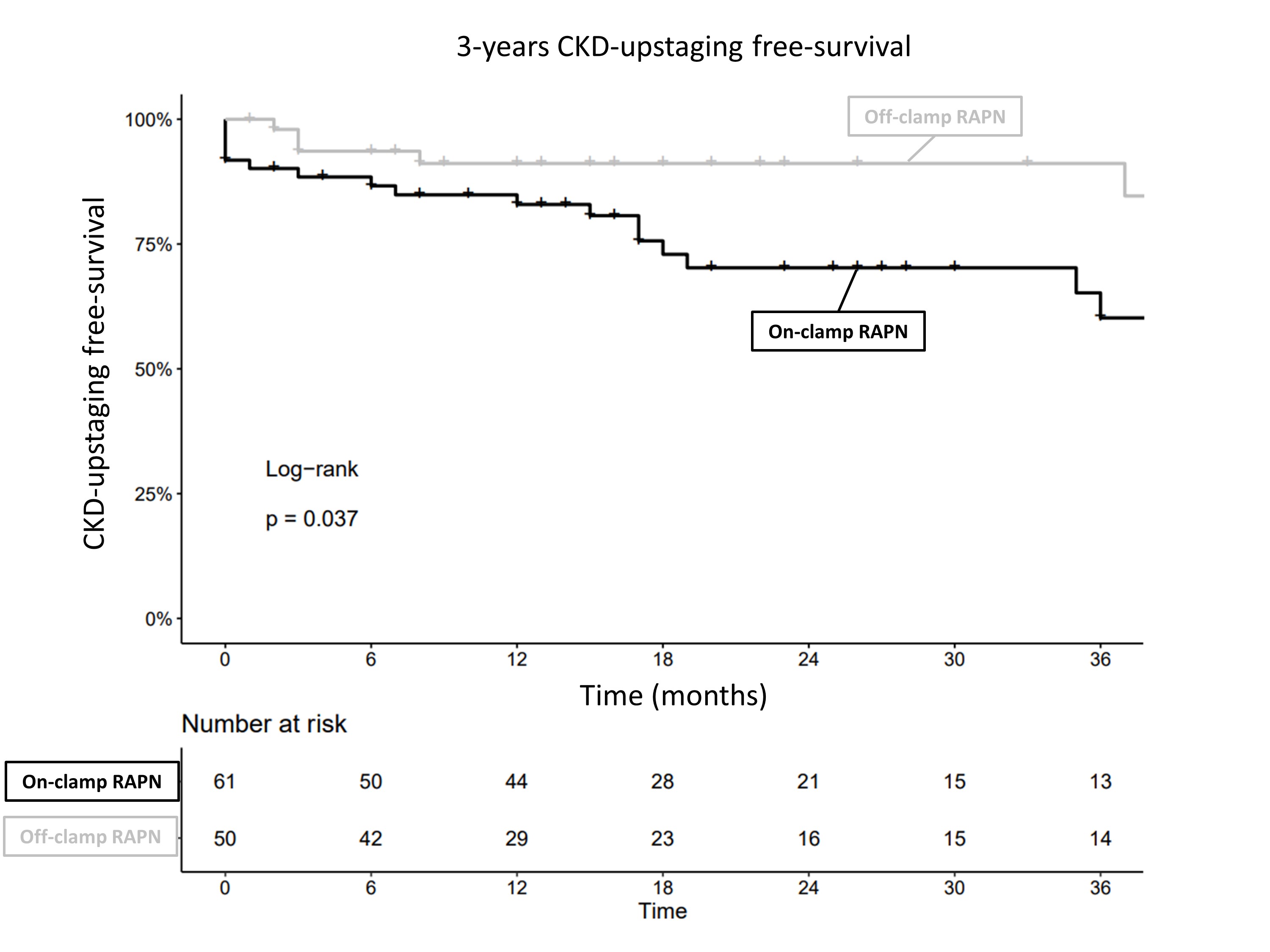Back
Poster, Podium & Video Sessions
Moderated Poster
MP50: Kidney Cancer: Localized: Surgical Therapy III
MP50-11: Head to head comparison between off-clamp vs on-clamp RAPN in high-risk RENAL score kidney tumors
Sunday, May 15, 2022
4:30 PM – 5:45 PM
Location: Room 225
Rocco Simone Flammia*, Umberto Anceschi, Antonio Tufano, Gabriele Tuderti, Rome, Italy, Alexander Kutikov, Robert G. Uzzo, Philadelphia, Philippines, Francesco Porpiglia, Cristian Fiori, Turin, Italy, Andrea Minervini, Florence, Italy, Umberto Capitanio, Milan, Italy, Riccardo Autorino, Richmond, VA, Michele Gallucci, Costantino Leonardo, Giuseppe Simone, Rome, Italy
- RF
Poster Presenter(s)
Introduction: The CLOCK trial found no differences between on clamp vs off-clamp RAPN. However, investigators relied mostly on cT1 patients with RENAL score = 10. In consequence, their results are not applicable to more complex and larger renal masses. To address this void we tested the association of off-clamp vs on-clamp RAPN with perioperative and functional outcome within a selective cohort of kidney tumor with high-risk RENAL score.
Methods: Within a multi-institutional database (2012-2019), we identified 116 patients treated with RAPN for kidney tumor harboring RENAL score = 10. Multivariable logistic regression models addressing trifecta achievement, linear regression model addressing postoperative eGFR and Cox regression models and Kaplan-Meier plots addressing any upstaging to CKD = 3a (CKD-upstaging) were applied according to off-clamp vs on-clamp RAPN. Covariates were preoperative eGFR, ASA, age, clinical tumor size and preoperative Hb. Trifecta was defined as the absence of any major complication plus negative surgical margin plus absence of postoperative AKI.
Results: Baseline characteristic are reported in Table 1. Overall 55 vs 66 patients were treated with off-clamp vs on-clamp RAPN, respectively. Off-clamp RAPN patients exhibited higher rate of trifecta achievement, that translated into a multivariable OR of 2.78 (1.25-6.46, p=0.014). Moreover, off-clamp RAPN were associated with higher postoperative eGFR at last follow up (linear coefficient +9.8, 95%CI 3.2-16.3, p=0.004). Kaplan-Meier plots depicted 3-years CKD-upstaging-free survival rates of 91% for off-clamp RAPN vs 60% for on-clamp RAPN, which translated in a protective multivariable HR of 0.23 (95%CI 0.08-0.63, p=0.005) in favor of off-clamp RAPN.
Conclusions: In patients treated for high-risk RENAL score kidney tumors, off-clamp RAPN is associated with better perioperative and mid-term functional outcome than their on-clamp counterparts.
Source of Funding: none


Methods: Within a multi-institutional database (2012-2019), we identified 116 patients treated with RAPN for kidney tumor harboring RENAL score = 10. Multivariable logistic regression models addressing trifecta achievement, linear regression model addressing postoperative eGFR and Cox regression models and Kaplan-Meier plots addressing any upstaging to CKD = 3a (CKD-upstaging) were applied according to off-clamp vs on-clamp RAPN. Covariates were preoperative eGFR, ASA, age, clinical tumor size and preoperative Hb. Trifecta was defined as the absence of any major complication plus negative surgical margin plus absence of postoperative AKI.
Results: Baseline characteristic are reported in Table 1. Overall 55 vs 66 patients were treated with off-clamp vs on-clamp RAPN, respectively. Off-clamp RAPN patients exhibited higher rate of trifecta achievement, that translated into a multivariable OR of 2.78 (1.25-6.46, p=0.014). Moreover, off-clamp RAPN were associated with higher postoperative eGFR at last follow up (linear coefficient +9.8, 95%CI 3.2-16.3, p=0.004). Kaplan-Meier plots depicted 3-years CKD-upstaging-free survival rates of 91% for off-clamp RAPN vs 60% for on-clamp RAPN, which translated in a protective multivariable HR of 0.23 (95%CI 0.08-0.63, p=0.005) in favor of off-clamp RAPN.
Conclusions: In patients treated for high-risk RENAL score kidney tumors, off-clamp RAPN is associated with better perioperative and mid-term functional outcome than their on-clamp counterparts.
Source of Funding: none



.jpg)
.jpg)